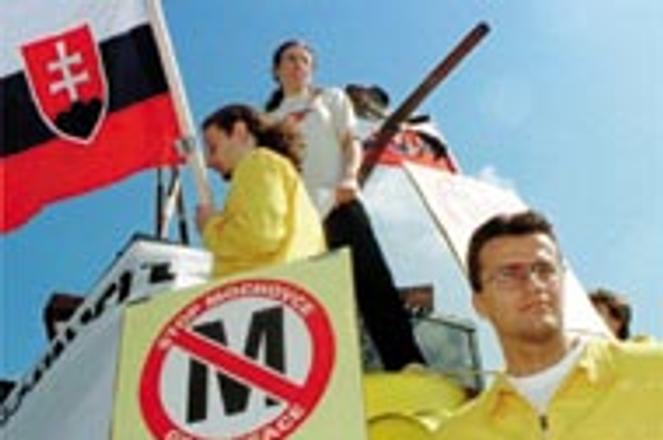Happy Chernobyl day. Greenpeace activists from Slovakia, Austria and Germany protest the Slovak government's decision to begin loading nuclear fuel rods at the Mochovce nuclear power plant on April 27, 12 years to the day after the world's worst nuclear accident.TASR
As commemorations go, the twelfth anniversary of the world's biggest nuclear catastrophe in Chernobyl, Ukraine, was an awkward occasion in Slovakia. Slovenské elektrárne (SE), a state-run electricity producer, chose the now-infamous 27th of April to begin loading the first two reactors of its controversial Mochovce nuclear power plant, located 100 kilometers east of the Austrian border, with Russian-made nuclear fuel rods. Environmentalists and the international community launched a fierce protest, citing safety concerns.
On the first day of loading, fifteen protesting Greenpeace activists chained themselves to the plant's entrance gate, delaying SE's plans for about an hour, but were swiftly cut free and detained by the police. 11 of the protesters, who hailed from Austria and Germany, were later banned from entering Slovakia for a year.
The incident led to protests against the supression of the non-violent demonstration. "I am ashamed of the way the police behaved to the foreigners," said Ľubica Trubíniová, the head of Slovakia's Greenpeace office, adding that the enforcers kicked and beat activists.
But Rastislav Petrech, the head of SE's Foreign and Public Affairs Office, told the Slovak press that by blocking the entrance, the Greenpeace activists had caused damages of 300,000 Sk ($9,000).
Concerned neighbors
Two days after the Greenpeace fire was extinguished, however, another blaze was kindled which proved much harder to put out. More than 30 European Parliament (EP) deputies urged Slovak Prime Minister Vladimír Mečiar in an open letter to halt the plant's launch, which had been set for July 21, until the completion of a scheduled May 5-9 inspection by international experts, and the elimination of all safety hazards.
"It's not a question of being for or against nuclear energy, it's a question of safety," said Marilies Fleming, an MEP for the Austrian People's Party (ÖVP), maintaining that "if operations started [without correcting] the shortcomings revealed [during the inspection], I am ready to march against the plant again."
According to Trubíniová, the EU will not accept low safety standards at East European nuclear power plants when considering these countries' applications for membership. "Premier Mečiar should not risk a crushing international defeat for Slovakia by ignoring the EP's requirements," said Trubíniová, who recently discussed the issue with MEPs in Brussels.
Corroborating Trubinová's words, Fleming announced on April 30 that a group of MEPs would ask the EP to hold an extraordinary debate on safety standards at Mochovce. "The Slovaks should know that if Prime Minister Mečiar launches the operation of a reactor that does not correspond to Western safety standards, Slovakia will not be accepted into the EU," she said, noting that no new member shall be accepted without the EP's consent.
Safety standards
Construction of the Soviet-designed plant began in the mid-1980s, but ceased in 1989 due to financial problems. Ever since, the stalled Mochovce project has been criticized by both western and domestic environmentalists and energy experts as being both outdated, dangerous and uneconomical.
"Mochovce does not meet the safety standards of EU countries," said Mária Mistríková, Secretary of Energia 2000 (E2000), an association of energy experts and scientists. Mistríková explained that all nuclear power plants in western Europe use a system of containment, which is normally a cement block reinforced with iron that covers the reactor and preserves environmental contamination in the case of a Chernobyl-like accident. "Mochovce is designed in a way that does not even allow for construction of a containment device because of the lack of space," she said.
But Alena Melichárková, SE spokeswoman, dismissed any comparison between Mochovce and Chernobyl, explaining that the two plants were of an entirely different type. "Comparing the Chernobyl power plant to Mochovce is deliberately misleading," she said.
Jozef Šucha, spokesman for the Economy Ministry, claimed that the plant is safe because its equipment supplier, the Czech company Škoda Plzeň, is a reliable and renowned company. "The safety of [Mochovce] is in my deepest interest, as I live near the place," he added.
E2000 economists calculated that the Mochovce plant will not produce the economic fruits that the Slovak government is anticipating. "It will kill Slovakia's economy," Mistríková said, explaining that if all costs are taken into account, the price of energy produced at Mochovce will be 300-400% higher than that is produced by current sources.
The plant has so far swallowed an investment of 25 billion Sk ($735 million), while a further 28 billion Sk is needed to finish the project. But Mistríková said overall costs are estimated at 300 billion Sk ($8.8 billion), after the costs of operation, maintenance and disposal of contaminated equipment and used fuel are taken into account.
"It is very expensive and not really safe," Mistríková said. Citing the example of a plant similar in design to Mochovce that is being dismantled in Greifswald in Eastern Germany, Mistríková revealed that the cost of de-commissioning such nuclear plants, which normally have a lifespan of only 25 years, is estimated to be 89 billion Sk ($2.7 billion).
"It was the best thing we could do [for Slovakia's future energy needs]," Šucha argued, noting that Slovakia currently imports some 10% of the electricity it consumes. "It is cheaper to produce energy than to import it. Society's consumption is so high that we cannot afford not to have such a producer," he said, explaining that Mochovce would be the final nuclear project to be completed in Slovakia after Parliament approved a resolution endorsing alternative energy sources.


